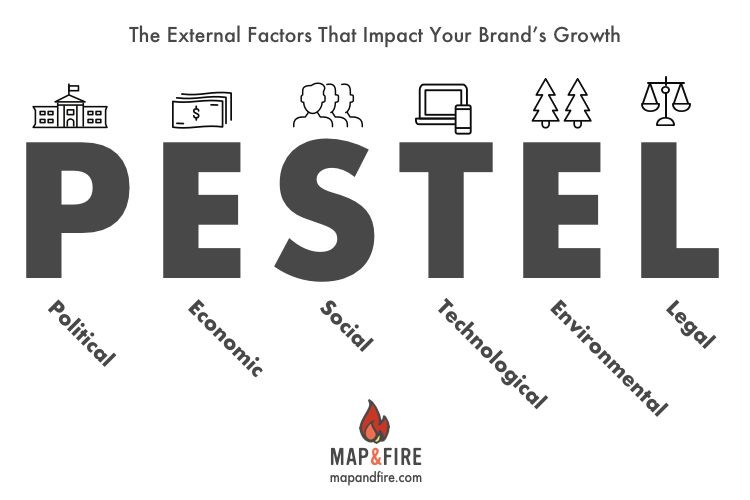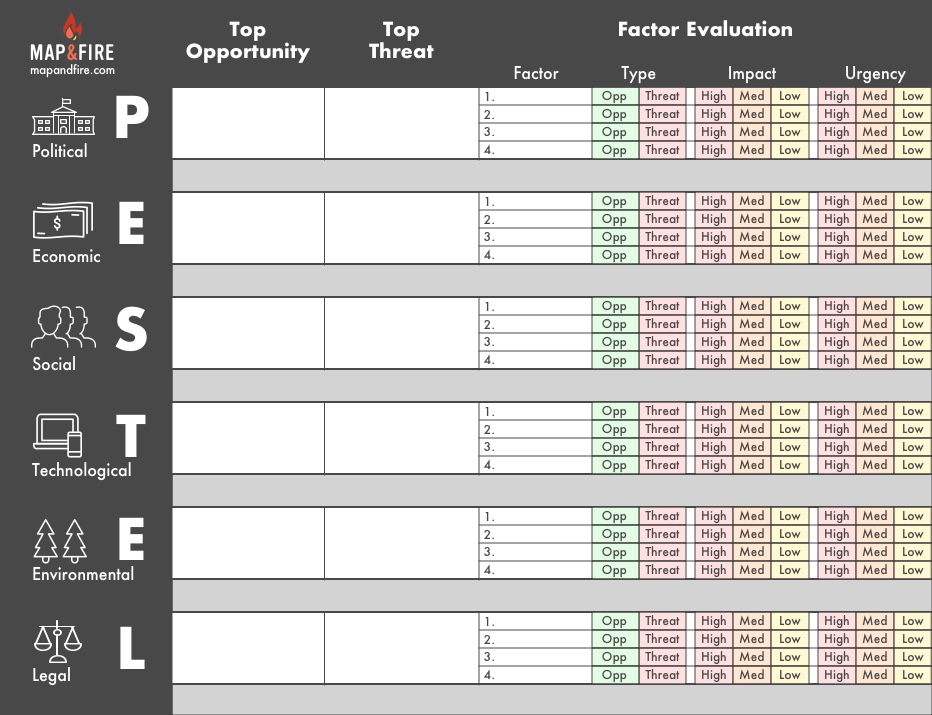PESTEL Analysis Framework
A simple and powerful way to identify and examine the external factors that may impact your brand’s growth.

Our Content Is Featured In:

Join 6,538 folks who receive our latest insights and you'll get immediate access to our 10 page brand strategy workbook!
Instantly analyze your brand
Use our new positioning app, SmokeLadder, to see where your B2B brand is strong, weak, and where it can stand out from the competition.
What Is PESTEL Analysis?
PESTEL Definition
At its core, PESTEL analysis is a framework to break down and examine the large external forces that affect every business. The acronym represents 6 categories of factors to consider:
- Political
- Economic
- Social
- Technological
- Environmental
- Legal

Variations of PESTEL
In other contexts, you may see this same idea expressed as just the shortened PEST, other variations like STEEPLE (which adds Ethics), DESTEP (which adds Demographics), SPELIT (which adds Intercultural), or simply an alternate spelling PESTLE.
One more version for geography-centric or global brands is LoNGPESTEL. This adds the analysis of the PESTEL factors relative to Local, National, and Global geographies.
Regardless of which variation you focus on, the principles are the same. It’s a framework that allows us to look at how external factors can create potential threats and opportunities for your business and brand.
As a little visual to help remember the name, you can think of a “pestle” (i.e. pestle and mortar) that’s applying specific pressure on your business. Or even a “pest” like an insect flying around that you need to keep an eye on.
PESTEL Analysis Categories and Factors
Here’s a breakdown of the 6 core PESTEL categories along with potential factors for each. Not all of these will be relevant for your brand, but reviewing the lists can make you aware of factors you may not have considered.
You can use these lists as thought starters for the PESTEL exercise and template below.
Political:
- Tax policy
- Trade restrictions
- Government subsidies
- Regulation
- Tariffs
- Labor laws
- Political stability
- Activism
- Competition regulation
Economic:
- Competitor prices
- Stock market health
- Exchange rates
- Inflation rates
- Unemployment rates
- Industry growth
- Loan access
- Interest rates
- Disposable income
Social:
- Buying habits
- Education access
- Health consciousness
- Population growth rates
- Cultural taboos
- Religious beliefs
- Immigration rates
- Life expectancy rates
- Age distributions
- Family size
- Career attitudes
- Social activism
Technological:
- Automation
- Internet access
- Mobile applications
- Communication infrastructure
- Machine learning
- Artificial Intelligence
- Autonomous vehicles
- Wearables
- Virtual Reality
- Augmented Reality
- Cloud migrations
- Blockchain
- Internet of Things (IoT)
- Computer hardware costs
- Security
- Biometrics
Environmental:
- Climate and weather
- Sustainability
- Environmental programs and initiatives
- Carbon footprint
- Product packaging
- Recycling
- Waste management
- Climate change
- Renewable energy
Legal:
- Copyright infringement
- Advertising standards
- Product labeling
- Intellectual property laws
- Privacy laws
- Data protection
- Discrimination laws
- Labor laws
- Competitive regulations
PESTEL Analysis Exercise and Template
One of the biggest limitations of many PESTEL templates is that they simply focus on helping you create lists of factors. Like any strategy exercise, the value in PESTEL comes from digging deeper, getting specific, and being thoughtful about how factors apply to your brand.
Map & Fire’s PESTEL template pushes you in this direction by adding classifications and grading:
- Opportunity vs. Threat: Classifying each factor as being a potential benefit or challenge for your brand
- Impact: Grading each factor on its relative impact to your brand
- Urgency: Grading each factor on the relative timing of its impact on your brand
- Identify The Top Factors: Using the grades to pull out the most important factors to focus on now
While this doesn’t replace the detailed discussion and analysis you need to do with your team, it provides additional structure to spark your thinking.
Exercise:
To get started on a PESTEL Analysis for your brand, you can follow these 5 steps:
- Selection: Select up to 4 factors that you feel are relevant to your brand for each of the 6 PESTEL categories
- Type: For each factor decide whether it represents an Opportunity for your brand or a Threat
- Impact: For each factor, grade how big of an impact it could have (or is having) on your brand (High = significant impact >> Low = minimal impact)
- Urgency: For each factor, grade the level of urgency there is to address it (High = must be dealt with asap >> Low = won’t be relevant in the near future)
- Top Opportunity and Top Threat: Taking into account the grades for each factor’s Impact and Urgency, select one Opportunity and one Threat that should receive the most resources and attention.

Note, you may have multiple Opportunities and Threats of similar weight so as a tie-breaker you can also consider which factors your team is best equipped to act on first.
As you you’re able to address factors you can revisit your list and reprioritize based on current market conditions and internal resource availability.
PESTEL Analysis Questions
Here are 5 questions to consider as you evaluate factors in your PESTEL Analysis:
- Is a factor that you viewed as a threat actually an opportunity? A service-based business may see the expansion of automation through AI and machine learning as a threat. However, if they embrace these changes they could be a in a unique position to take advantage of these technologies with their expertise.
- How do these factors affect your target customers? While the focus of this work is on your business and brand, you should always think through the lens of your customers. What factors do they view as being important even if they’re not a current focus for your business.
- Which factors have the biggest impact on buying decisions? There will always be tradeoffs around areas of cost and quality. Your offering’s quality can also have a big impact on areas like sustainability. Where so you want to invest and what factors are most important to your target audience?
- Which factors might have the biggest impact on your long term success? There may be factors that don’t feel as urgent right now, but their long term impact could be huge. Again, looking at things like emerging technologies. Ignoring those trends today could catch your brand flat-footed in a few years.
- Where are your competitors investing? Keep an eye on where your competition is investing to avoid getting left behind. Monitor shifts in their products and even their content (i.e. blog articles, white papers, etc) to get a feel for the directions they may be headed.
PESTEL Analysis Examples
Below are examples of a high level PESTEL Analysis for Tesla and Netflix. This represents some initial factors that would be relevant to their brands.
Tesla:
Political
- Government support for auto manufacturers
- Incentives for purchasing electric vehicles
- Trade regulations for components like their batteries (China, Japan, South Korea)
Economic
- Price of materials
- Growing shifts in consumer preference to purchasing electric vehicles
- Renewable energy costs decreasing
- Low interest rates for purchasing
Social
- Growing interest in environmental sustainability
- Awareness of carbon emissions
- Access to highly skilled engineering talent
Technological
- Emergence of autonomous vehicles
- Decreased dependence on vehicle ownership through ride sharing
- Increase in electric vehicle options
Environmental
- Need for reduction of carbon emissions
- Need for ways to utilize renewable energy
- Expansion of environmental programs
Legal
- Intellectual property protection
- Dealership model regulations
- Antitrust laws
Netflix:
Political
- Government restrictions on service access
- Government restrictions on specific content
- Foreign tax policies
Economic
- Unemployment rates affecting spending
- Costs of content licensing
- Costs of original content development
- Expansion of one-off subscription services
- Fluctuating exchange rates
Social
- Content diversity per country and regions
- Cultural preferences per country and region
- Preferences and behaviors of younger digital-first demographics
Technological
- Machine learning driven algorithms for recommendations
- Streaming content accessible across all platforms
- Dynamic content curation across different regions and languages
Environmental
- Focus on using renewable energy
- Reduction of carbon footprint
Legal
- Copyright laws across regions
- Video piracy
- Antitrust laws
Get Help Finding The Factors That Impact Your Brand

Free Brand & Marketing Workbook
Get immediate access to our 10 page workbook to help you define your Core Purpose, Vision, and Core Values, along with resources for Brand Archetypes, Tone of Voice, Messaging, and more!

Hands-on Brand Strategy Help
Transform your best business thinking into an actionable, shareable, growth-oriented guide. Click below to learn about the Brand Guidebook process.

